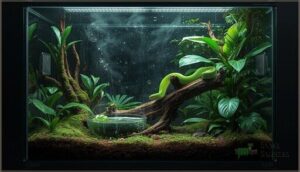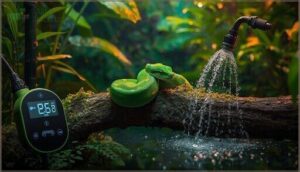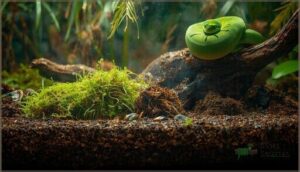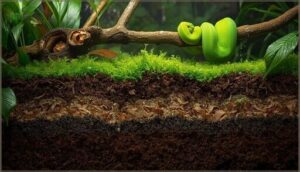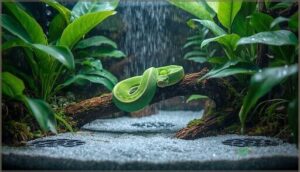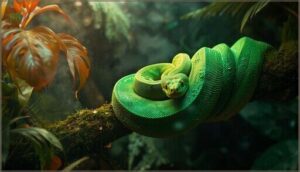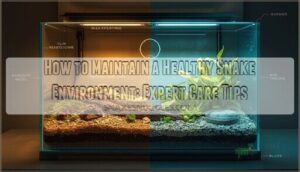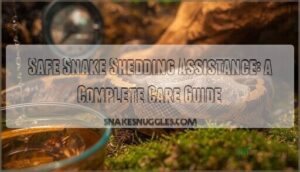This site is supported by our readers. We may earn a commission, at no cost to you, if you purchase through links.

Getting humidity right isn’t just about preventing a bad shed; it’s the difference between a snake that feeds eagerly and climbs confidently versus one battling respiratory infections or skin lesions. The 50-70% range might sound simple, but achieving it consistently requires understanding how your enclosure breathes, what your substrate does at 2 AM, and why that water bowl placement matters more than you’d think.
Table Of Contents
- Key Takeaways
- Ideal Humidity Range for Green Tree Pythons
- Factors Affecting Enclosure Humidity
- Methods to Monitor and Control Humidity
- Substrate and Environmental Setup Tips
- Preventing Health Issues Linked to Humidity
- Frequently Asked Questions (FAQs)
- How much humidity does a green tree python need?
- How to keep green tree pythons healthy?
- Do green tree pythons need a hygrometer?
- How deep should a green tree python substrate be?
- How to humidify a green tree python terrarium?
- What are the enclosure requirements for green tree pythons?
- How often should I mist my pythons enclosure?
- Can I use a humidifier for consistent humidity?
- What humidity level is best for hatchlings?
- Does nighttime humidity need to be different?
- Conclusion
Key Takeaways
- Green tree pythons thrive best when humidity is kept between 50% and 70%, with a bump to 60–70% during shedding.
- Poor humidity control can lead to stuck sheds, dehydration, respiratory infections, and skin problems.
- The enclosure’s material, substrate type and depth, ventilation, and even water bowl placement all play key roles in maintaining steady humidity.
- Accurate monitoring with a digital hygrometer and using automated misting or humidity gradients make it easier to keep conditions ideal.
Ideal Humidity Range for Green Tree Pythons
Achieving the humidity balance isn’t just about selecting a number—it’s about creating an environment where your green tree python can flourish.
You must understand what levels are best, why they’re important for your snake’s health, and what occurs if things go awry.
Let’s break down the key points you need to know.
Recommended Humidity Levels (40%-70%)
If you’re keeping green tree pythons, maintaining humidity between 40% and 70% isn’t just a suggestion—it’s the foundation of their respiratory health and skin condition. The best range bolsters natural behaviors and prevents common health problems. What appropriate humidity requirements of pythons resemble in practice:
- 50-60% functions as your sweet spot for consistent humidity throughout of the year
- Bump levels to 60-70% during shedding cycles to prevent incomplete skin removal
- Never drop below 40%—dehydration risks escalate quickly at lower levels
- Avoid sustained periods above 70% where respiratory infections become likely
- Daily monitoring uncovers patterns in maintaining humidity levels effectively
Your snake’s health indicators—clear eyes, smooth skin, and regular breathing—confirm you’ve nailed the best humidity.
Importance for Shedding and Health
Humidity regulation directly impacts shedding efficiency—green tree pythons in the 50-70% range show a 95% complete shed success rate, whereas inadequate moisture causes stuck shed in up to 65% of cases. Beyond healthy shedding, ideal humidity prevents respiratory health complications, lessens skin lesions by 30%, and furthers physiological benefits like 30% more stable hydration.
You’ll notice behavioral indicators too: snakes display 20% more natural activity and feeding responses if humidity’s dialed in correctly. These snakes are native to tropical rainforests in New Guinea.
Risks of Incorrect Humidity
Stray beyond the 40-70% range, and health risks spike fast. Humidity below 40% triggers dehydration in approximately 23% of captive individuals, along with shedding problems affecting up to 34% of snakes—stuck shed stresses internal organs and delays recovery.
Meanwhile, levels above 75% more than double your python’s risk of bacterial growth, skin problems, and respiratory infections, with captive collections reporting infection susceptibility jumps of 40% or more. Snakes may also be vulnerable to infectious stomatitis if kept in improper conditions.
Behavioral stress, organ damage, and secondary infections follow if humidity remains incorrect long-term.
Factors Affecting Enclosure Humidity
Your enclosure design plays a bigger role in humidity than you might think. The materials you select, how air moves through the space, and even where you place the water bowl all work together to either hold moisture in or let it escape.
Let’s look at the key factors that directly affect your green tree python’s humidity levels.
Enclosure Size and Materials
The size of your green tree python’s enclosure and what it’s made from directly shape how well you can hold humidity at that important 50-70% sweet spot.
Here’s what really makes a difference:
- Enclosure dimensions should prioritize vertical space—these arboreal snakes require height for moving around and establishing a thermal gradient with adequate hiding spots.
- Material safety is key: glass or PVC retains moisture better than screen enclosures, which leak humidity quickly.
- Substrate depth of 2-4 inches using natural leaf litter or moisture-retentive materials aids consistent humidity levels.
- Enclosure ventilation requires balance—enough airflow prevents mold without drying out your whole system.
Air Circulation and Ventilation
While you’ve locked down the correct materials and dimensions, airflow becomes the invisible partner that keeps humidity stable without turning your enclosure into a breeding ground for mold or respiratory trouble.
Strategic vent placement—commonly mesh vents positioned on opposite sides—establishes natural airflow patterns that revitalize air quality without crashing humidity levels. Suitable air circulation prevents stagnant pockets where bacteria flourish, directly supporting respiratory health.
Balance is everything: too little ventilation invites mold prevention nightmares, whereas excessive airflow dries out your carefully managed environment.
Substrate Depth and Type
Your substrate choice acts as the foundation’s moisture reservoir, directly influencing how long humidity persists between mistings and whether your green tree python’s environment remains comfortably stable or swings wildly throughout the day.
Coconut fiber, cypress mulch, and sphagnum moss are outstanding at moisture retention while supporting naturalistic substrate aesthetics. Substrate layering at 2–4 inches deep strikes a balance between humidity control and arboreal safety—your python won’t risk injury during infrequent ground excursions.
Substrate depth affects how effectively moisture releases gradually rather than evaporating within hours.
Water Source Placement
Positioning a water bowl thoughtfully converts it from a simple drinking station into a humidity-boosting tool that quietly functions around the clock. Position your water bowl at mid-enclosure height to heighten evaporation without drenching the substrate below.
Water bowl size matters—larger surface areas release more moisture into the air, stabilizing humidity levels between mistings.
Change water daily and scrub bowls thoroughly to prevent bacterial buildup that compromises both water quality and your python’s health.
Methods to Monitor and Control Humidity
Maintaining humidity steady involves tracking it carefully and adjusting conditions as needed. You’ll require the appropriate tools to measure moisture levels and practical ways to increase or decrease them as your python requires.
Here’s what you’ll need to keep an eye on humidity and adjust it for your green tree python’s home.
Using Digital Probe Hygrometers
If you’re relying on guesswork to gauge your enclosure’s humidity, you’re basically flying blind—and your green tree python’s health depends on precision, not approximation.
Digital hygrometers with external probes deliver precise measurements when placed at perch height where your snake actually rests. Look for models with data logging capabilities to track daily fluctuations, and remember that calibration needs and battery life matter—accuracy degrades over time without proper maintenance.
Misting Systems and Humidity Controllers
Automating humidity control isn’t just convenient—it’s the difference between daily manual misting and a system that maintains ideal conditions while you’re at work or asleep.
Automatic misting systems with humidity controllers adjust output based on real-time hygrometer readings, but you’ll need proper controller calibration and strategic nozzle placement to avoid oversaturating perches.
Set timer settings for short bursts rather than continuous spray, and don’t skip system maintenance—clogged nozzles ruin consistency fast.
Creating Humidity Gradients
Think of your enclosure like a rainforest canopy—humidity isn’t uniform from ground to treetop, and your green tree python shouldn’t experience it that way either. Creating a humidity gradient gives your snake microclimate options to self-regulate based on its needs.
- Position water sources low to increase humidity near the substrate through natural evaporation rates
- Keep basking spots drier at the top, allowing vertical humidity variation
- Mist one side more heavily to establish distinct zones within the enclosure environment
- Monitor multiple levels with separate hygrometers for accurate gradient tracking
This gradient approach aids natural thermoregulation and gives you better humidity control overall.
Observing Snake Behavior for Clues
Beyond setting up the right gradient, your snake will tell you whether it’s working—green tree pythons are surprisingly transparent about their comfort levels if you know what to watch for.
Watch for incomplete shedding cycles, reduced activity levels, or labored breathing patterns—these signal humidity problems affecting snake health.
Healthy green tree pythons show consistent eating habits, smooth skin condition, and normal respiratory health between shedding behavior episodes, confirming your humidity level is spot-on.
Substrate and Environmental Setup Tips
Your substrate choice directly impacts how well your enclosure holds moisture and whether it stays safe for your snake. The right setup means less work maintaining humidity and fewer health risks down the road.
Let’s look at what works best for keeping green tree pythons healthy.
Choosing Moisture-Retentive Substrates
When you’re setting up a green tree python enclosure, the substrate you choose acts like a moisture reservoir—some materials hold humidity far better than others.
Here are some of the best choices for holding in moisture:
- Coconut fiber – absorbs well and resists mold with proper ventilation
- Cypress mulch – naturally antifungal and maintains moisture balance
- Sphagnum moss – excellent for humid microclimates but needs rotation for mold prevention
- Plantation soil blends – mimic natural materials while supporting arboreal safety
Proper substrate layering keeps your python healthy without sacrificing air quality.
Layering and Depth Recommendations
Your substrate depth directly affects how well your enclosure holds and releases moisture throughout the day. Aim for 2 to 4 inches—this layering benefits humidity stability while supporting arboreal safety when your python moves to ground level.
Coconut fiber mixed with sphagnum moss creates excellent moisture retention, and adding natural leaf litter on top mimics their native habitat. Proper material choice and substrate depth work together to maintain moisture balance without waterlogging.
Preventing Mold and Bacterial Growth
High humidity without proper maintenance turns your carefully prepared substrate into a breeding ground for mold and harmful bacteria. Daily spot cleaning removes waste and uneaten food, while proper ventilation and airflow optimization prevent stagnant pockets where pathogens thrive.
Monitor water quality in bowls, replace damp substrate sections promptly, and ensure enclosure cleaning follows a regular schedule to maintain safe air quality alongside effective humidity control.
Preventing Health Issues Linked to Humidity
Getting humidity right isn’t just about comfort—it’s about keeping your green tree python healthy and free from preventable problems.
When humidity levels stray too far from the ideal range, your snake faces real risks, from respiratory infections to stubborn skin issues. Let’s look at the key health concerns you need to watch for and how to stay ahead of them.
Respiratory Infections and Skin Problems
Humidity-related complications can devastate your green tree python’s health faster than you might expect. Respiratory infections strike nearly 59% of serpentovirus-positive collections, while skin problems like scale rot thrive in overly moist conditions. Here’s what you need to watch for:
- Clinical signs of respiratory disease include open-mouth breathing, mucus discharge, and lethargy—often appearing suddenly
- Skin lesions and scale discoloration signal infection prevalence, especially on ventral surfaces contacting damp substrate
- Humidity control between 50-70% with proper ventilation reduces infection risk by over 30%
Disease prevention starts with monitoring humidity levels daily and recognizing early symptoms. Veterinary intervention proves essential—prompt treatment resolves most cases before complications develop into systemic infections.
Regular Hygiene and Enclosure Maintenance
Daily maintenance routines make the difference between a thriving python and one battling preventable infections. You’ll need spot cleaning for waste removal each day, along with water sanitation.
Replace substrate monthly during full cage cleaning sessions using reptilesafe disinfectant following proper disinfection protocols.
Don’t overlook UVB impact on humidity—regular monitoring keeps bacterial growth in check.
Veterinary Care and Monitoring
Even with excellent husbandry, spotting the early warning signs of humidity-related illness requires a veterinarian trained in reptile medicine—your observations matter, but expert diagnosis saves lives.
Schedule regular checkups every six months to catch respiratory infections before they escalate. Watch for these symptoms requiring immediate expert consultation:
- Labored breathing or wheezing sounds
- Incomplete sheds with retained eye caps
- Lethargy combined with refusing meals
Quarantine protocols and parasite prevention strengthen your snake’s defenses against health risks that humidity alone can’t fix.
Frequently Asked Questions (FAQs)
How much humidity does a green tree python need?
Picture mist clinging to emerald scales as your snake explores its canopy perch.
Green tree pythons thrive with humidity levels between 50% and 70%, essential for proper shedding and respiratory health. Maintaining ideal humidity prevents dehydration and skin problems.
How to keep green tree pythons healthy?
Green Tree Python health hinges on proper hydration, ideal humidity for respiratory health, and preventing shedding problems or skin infections.
Monitor humidity control daily, watch for respiratory issues, and schedule regular veterinary checkups to catch problems early.
Do green tree pythons need a hygrometer?
Absolutely—a digital hygrometer isn’t optional; it’s essential. Without accurate humidity tracking, you’re guessing at levels that directly impact respiratory health and successful sheds. Analog alternatives exist but lack the precision needed for maintaining humidity levels between 40-70%.
Placement matters too—position your hygrometer mid-enclosure where your python spends most time, and calibrate it monthly for reliable data interpretation and effective humidity control.
How deep should a green tree python substrate be?
A substrate depth of 2 to 4 inches works well for moisture retention and humidity control.
This layering provides arboreal support, creates a moisture gradient, accommodates rooted plants, and allows some burrowing behavior.
Coconut fiber is excellent for enclosure setup.
How to humidify a green tree python terrarium?
To maintain proper terrarium humidity, you’ll need a combination approach. Misting systems deliver scheduled moisture automatically, while manual spraying gives you precise control.
Humidifiers add ambient moisture, and fog generators create naturalistic conditions that complement moisture-retentive substrates and water features.
What are the enclosure requirements for green tree pythons?
Your Green Tree Python needs a vertical enclosure—at least 18x18x24 inches for adults—packed with horizontal branches at various heights.
Temperature Gradient matters: maintain 78-82°F ambient with an 88-90°F basking spot, plus Hiding Places and strategic ventilation for comfort.
How often should I mist my pythons enclosure?
Misting frequency depends on several factors, including enclosure ventilation and substrate type. Most keepers mist once daily, but monitor your humidity levels with a digital hygrometer—you might need twice-daily sessions during dry seasons or when using manual misting instead of automated systems.
Can I use a humidifier for consistent humidity?
Using a humidifier for consistent humidity works well if you choose appropriate humidifier types and manage safety concerns.
Proper humidifier placement, regular maintenance, and backup misting systems guarantee safe humidity control as part of your humidity management plan.
What humidity level is best for hatchlings?
For hatchlings, aim for a humidity level close to 65–70% to support hydration needs, steady growth rates, and smooth shedding.
Smaller enclosure size and higher misting frequency help maintain a gentle humidity gradient.
Does nighttime humidity need to be different?
As dusk settles in tropical rainforests, a gentle Nighttime Spike in humidity mimics natural fluctuation.
For your Green Tree Python, this diel cycling aids normal respiratory function—so allowing slightly higher humidity levels overnight fits a healthy misting schedule.
Conclusion
Imagine one missed spray and those lush coils gather dust—humidity drops, trouble brews.
When you lock in that perfect green tree python humidity requirement, you haven’t just hit a number—you’ve recreated a living, breathing ecosystem. Each dialed-in mist, every strategic vent, brings your python one step closer to thriving.
Watch how those scales gleam, how feeds come easier. Mastering this balance isn’t luck—it’s attentive husbandry, and your python’s health quietly thanks you for every well-tuned decision.

